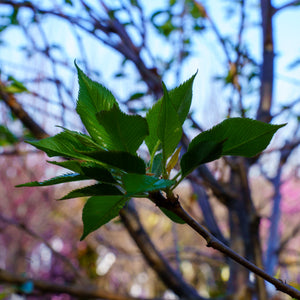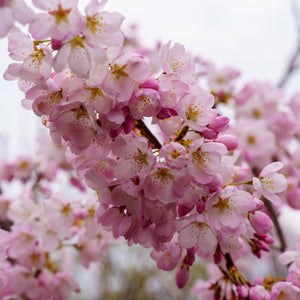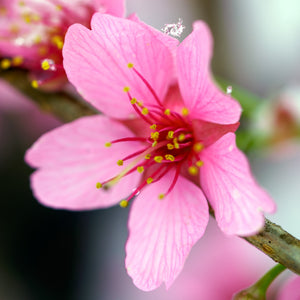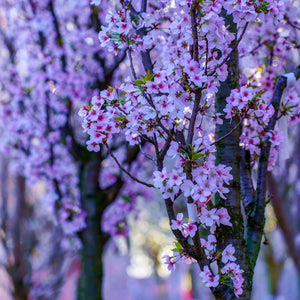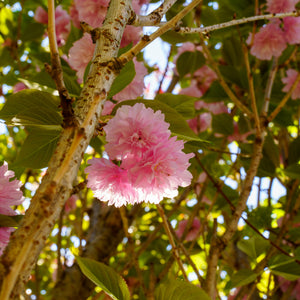The Flowering Cherry Guide
Flowering cherry trees (genus Prunus) are among the most celebrated ornamental trees in the world, renowned for their breathtaking springtime blooms and elegant forms. These deciduous trees, often associated with renewal and beauty, offer a stunning display of soft pink to pure white blossoms, captivating gardeners and landscape designers alike. With graceful branching habits, attractive bark, and seasonal color changes, flowering cherry trees make excellent focal points in gardens, parks, and formal landscapes.
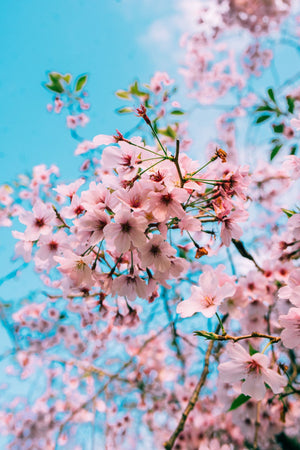
About
The Prunus genus includes a diverse group of flowering cherry trees, each with its own unique beauty and growth habit. Prunus subhirtella varieties, such as 'Accolade' and 'Autumnalis', are prized for their early and sometimes even winter blooming habits, providing color when few other trees are in flower. Weeping forms like Prunus subhirtella 'Pendula' and Prunus x 'Snofozam' (Snow Fountains® Cherry) offer cascading branches covered in clouds of blossoms, creating dramatic landscape features.
Japanese cherry trees (Prunus serrulata), including favorites like 'Kwanzan', 'Snow Goose', 'Mount Fuji', and 'Royal Burgundy', showcase fuller, often double-petaled blooms and richly colored new foliage. Meanwhile, hybrids like Prunus × yedoensis and its cultivar 'Akebono' are revered for their abundant, delicate flowers and wide-spreading canopies, making them centerpieces of many cherry blossom festivals worldwide.
Flowering cherry trees are celebrated not only for their blossoms but also for their attractive bark, refined branching, and vivid fall foliage, providing multi-season interest even after their fleeting bloom season ends.
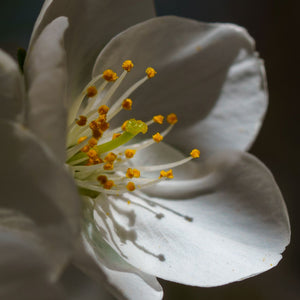
PLANTING
Proper planting ensures flowering cherry trees establish quickly and thrive for many years, delivering their famous springtime spectacle.
USDA Hardiness Zones: Most flowering cherries grow well in Zones 5–8, although some varieties can extend into Zone 9 with proper care.
Soil: Prefers moist, well-drained, fertile soil. Flowering cherries dislike heavy, poorly drained clay soils and benefit from slight soil acidity.
Sunlight: Full sun (at least six hours of direct sunlight daily) is essential for abundant blooming and healthy growth.
Watering: Regular watering is crucial, especially during the establishment period and dry spells. Established trees are moderately drought-tolerant but perform best with consistent moisture.
Spacing: Space trees according to mature canopy width. Upright varieties like Prunus sargentii 'Columnaris' need about 15–20 feet, while broader types like Prunus × yedoensis may need 25–30 feet.
Planting Time: Early spring or early fall is the ideal time to plant flowering cherry trees, allowing roots to establish before the stresses of summer heat or winter cold.
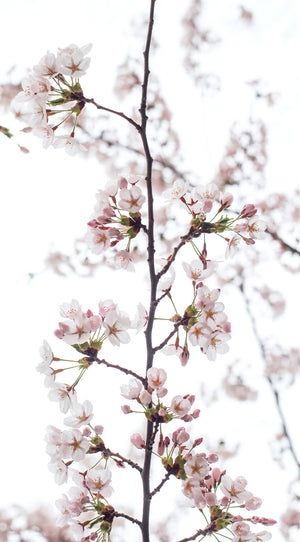
CARE
While flowering cherries require some maintenance, their spectacular beauty makes the effort worthwhile.
Watering: Deep watering during dry periods supports healthy flowering and minimizes stress. Avoid overwatering, as standing water can cause root diseases.
Fertilizing: Apply a balanced, slow-release fertilizer in early spring just before new growth begins. Avoid excessive nitrogen, which can promote leaf growth at the expense of flowers.
Pruning: Prune in late winter or early spring before bud break. Focus on removing dead, diseased, or crossing branches to maintain structure and encourage air circulation. Light shaping can enhance the natural form but avoid heavy pruning.
Pests & Diseases: Flowering cherries can be susceptible to pests like aphids, scale, and borers. Common diseases include leaf spot, powdery mildew, and canker. Good cultural practices, such as proper spacing and pruning, help minimize problems.
Mulching: A 2–3 inch mulch layer helps retain soil moisture, regulate temperature, and suppress weeds. Keep mulch several inches away from the trunk to prevent rot and pest issues.
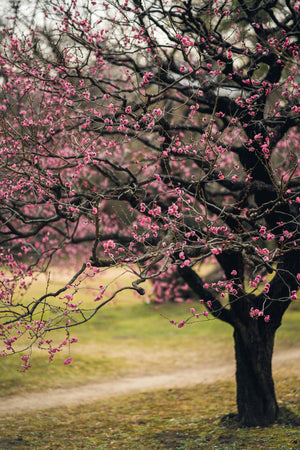
HOW TO USE
Flowering cherry trees offer tremendous flexibility in the landscape, providing breathtaking beauty and graceful structure.
Specimen Trees: Trees like Prunus serrulata 'Kwanzan' or Prunus x 'Okame' make stunning stand-alone specimens for lawns, courtyards, or public gardens.
Ornamental Allees: Rows of flowering cherries, such as Prunus × yedoensis 'Akebono', create unforgettable seasonal displays along driveways, walkways, or garden paths.
Weeping Accents: Cascading forms like Prunus x 'Snofozam' or Prunus subhirtella 'Pendula' add movement and softness to formal gardens, water features, or Japanese-style landscapes.
Small Gardens: Narrow or upright varieties like Prunus sargentii 'Columnaris' provide cherry blossom magic in limited spaces without overwhelming small gardens.
Seasonal Displays: Plant flowering cherries near early-blooming bulbs such as daffodils or underplant with low-growing groundcovers like Phlox subulata for a layered, colorful spring display.
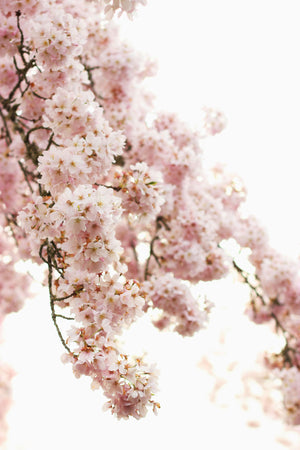
Common Questions
Are cherry blossoms flowers? Yes, cherry blossoms are the flowers of several Prunus species, prized for their ephemeral beauty and symbolic significance.
How to plant a flowering cherry tree? Choose a sunny, well-drained location. Dig a hole twice as wide as the root ball but no deeper. Position the tree so that the top of the root ball is level with the ground surface. Backfill with native soil, water thoroughly, and mulch around the base, keeping mulch away from the trunk.
What does a flowering cherry tree look like? Flowering cherry trees typically feature graceful, spreading canopies or pendulous branches covered in profuse blooms each spring. Flowers range from pure white to deep pink, often in single or double forms. Many varieties also offer vibrant fall color and attractive bark.
How to prune a flowering cherry tree? Prune during late winter or very early spring. Focus on removing dead, damaged, or diseased wood. Lightly shape to maintain natural form but avoid drastic cuts, as flowering cherries do not respond well to heavy pruning.
When to plant a flowering cherry tree? Plant flowering cherry trees in early spring or early fall to give them time to establish before the extreme temperatures of summer or winter.
How long do flowering cherry trees live? Most ornamental cherries live 20–40 years, though some varieties may live longer with ideal care. Factors like disease pressure and soil conditions can impact longevity.
Do flowering cherry trees produce fruit? Many ornamental varieties produce small fruits, but they are often sparse, not particularly showy, and usually not suitable for human consumption.
When do cherry blossoms appear? Cherry blossoms typically appear in early to mid-spring, although varieties like Prunus subhirtella 'Autumnalis' may flower sporadically in late fall and winter.
How long do cherry blossoms last? Cherry blossoms are fleeting, generally lasting 1 to 2 weeks depending on weather conditions. Wind, rain, and temperature fluctuations can shorten the bloom period significantly.
Conclusion
Flowering cherry trees are enduring symbols of beauty, renewal, and elegance. With their breathtaking spring displays, graceful forms, and multi-season appeal, they enrich landscapes large and small. Thoughtful selection, planting, and care ensure these remarkable trees will provide years of seasonal drama and timeless charm, anchoring gardens and public spaces with their unforgettable presence.

